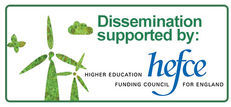The Enterprise Centre: Celebrating localism and low carbon futures at UEA
The University of Anglia’s (UEA) Enterprise Centre (TEC) is one of the UK’s most sustainable buildings. It is a centre for student entrepreneurship, and a regional hub for innovators and businesses committed to a low carbon future.
The first of its kind, TEC is a pioneering project achieving both Passivhaus Certification and BREEAM Outstanding, two of the most rigorous sustainable built environment standards. The predicted lifecycle CO2 emissions over 100-year life cycle period are 20–25% of those of other university buildings with a similar size and usage.
Emissions associated with construction were minimised through the innovative use of natural and recycled materials. Where possible these were sourced, tested and fabricated locally including regional timber, original ‘cassette technique’ thatching to external walls and a low carbon concrete.
Built on a brownfield site the timber frame building was conceived as an ecological interpretation of UEA’s unique architectural legacy and embodies UEA’s sustainability priorities.
Top 3 learnings
1 Vision: Consider delivery strategy if your aim is to produce a brief that is innovative, ambitious and inspirational. Develop a strategy to deliver this brief, rather than fostering innovation, ambition and inspiration that is compromised by perceived constraints and potential obstacles. Get vision input from all stakeholders. We set ourselves a low carbon challenge at every element of the project, resulting in new local industries and building materials – your vision has the potential to inspire much wider social and environmental benefits.
2 Evolution: Be prepared to innovate and evolve your original strategy to ensure that the original vision is not compromised. Try to look for progressive solutions and opportunities from issues and obstacles, and get input from all stakeholders.
3 Communication: Do your best to ensure that high quality and inclusive communication is maintained throughout the project to all stakeholders, with opportunities to receive their feedback. Try to ensure that all inputs are considered and all expectations managed and, where possible, met.
CO2t Savings: 20,800
Actual/Estimated: Estimated
No. of yrs: 100
Videos








 Except where otherwise stated, content on this site is
licensed under a Creative Commons Attribution 3.0 License.
Except where otherwise stated, content on this site is
licensed under a Creative Commons Attribution 3.0 License.
